
- Home
- Workshops / Tours
- Diary / Blog
- Galleries
- Foreign Trips
- Tasmania 2016
- NE Queensland 2016
- Western Alps 2016
- NE Spain 2016
- Australia's Wet Tropics 2015
- Australia's Top End 2015
- SW Australia 2015
- Switzerland 2015
- Andalucia 2015
- Belize 2015
- Australia 2014
- Switzerland 2014
- Belize 2014
- Bahama Islands 2014
- Switzerland 2013
- Ecuador 2012-2013
- Florida 2011-2012
- Vancouver Island 2011
- Australia 2010
- Peru 2008
- Bulgaria 2007
- Lesvos 2006
- California 2006
- New Zealand 2005
- Extremadura 2005
- Goa, India 2004
- The Gambia 2003
New Zealand
5th November - 4th December 2005
Tiritiri Matangi Island: Part 1
The small (2.2km2) island of Tiritiri Matangi, lying just 30km north-east of Aukland city centre, has undergone an amazing transformation over the last 20 years and is an excellent example of just what can be achieved given huge amounts of dedication, hard work and money.
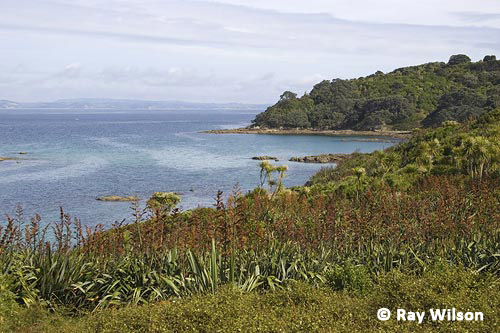
View from Wharf Road towards Hobbs Beach
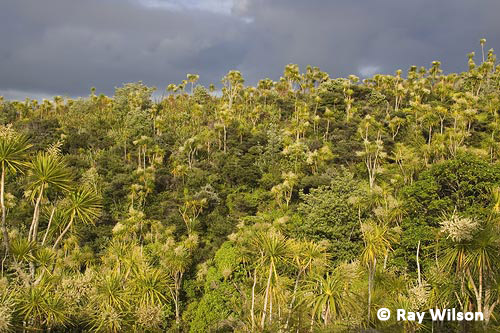
Cabbage Trees in Wattle Valley, Tiritiri Matangi Island
Over 120 years of farming on the island had left just 6% of its native bush by the early 80's. During the next 10 years over 250,000 native trees and bushes were planted and the introduced mammalian predators eradicated. Once sufficient cover had been established, rare and endangered native birds were re-introduced. Today, the island is 60% forested, with the remainder being managed as grassland to maintain habitat for species such as the Takahe.

Takahe (Porphyrio mantelli) - more Takahe photos
In total, 11 species have now been re-introduced: Takahe, Stitchbird, Kokako, Saddleback, Little Spotted Kiwi, Whitehead, New Zealand Robin, Brown Teal, Red-crowned Parakeet, Fernbird, and Tomtit. The Tomtit introduction appears to have been unsuccessful and there is doubt as to whether there are any still on the island, but most of the others can be easily seen within a day trip to the island (except the Kiwis which require an overnight stay).
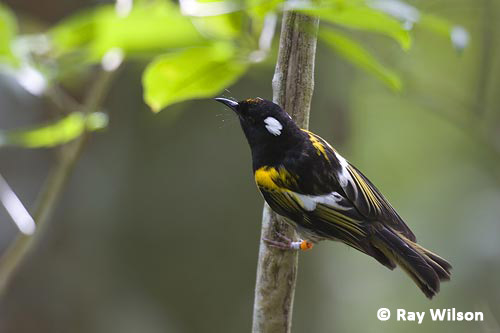
Stitchbird (Notiomystis cincta)
Currently, Stitchbird is only found on 4 predator-free islands: Little Barrier (its only natural population), Kapiti, Mokoia and Tiritiri Matangi. On Tiritiri, the population is thriving but the forests are not yet mature enough to provide sufficient nectar-producing flowers throughout the year and feeding stations have to be provided to help the birds survive. It is hoped that these feeding stations will become redundant once the trees are old enough to produce abundant flowers. The best place to see the Stitchbirds is along the Kawerau track, where they are common, but they can also be seen along the Wattle Valley Track.
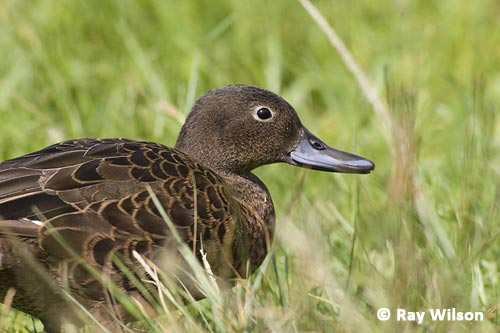
Brown Teal (Anas aucklandica)
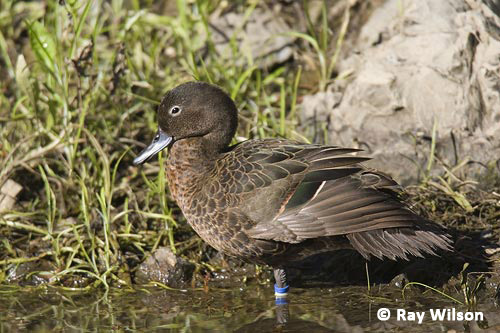
Brown Teal (Anas aucklandica)
Captive-bred Brown Teal have been released on several small ponds on Tiritiri, but the pond next to the road a couple of hundred metres from the wharf is by far the easiest place to see them. If you are lucky, Spotless Crake can also be seen on the pond margins.
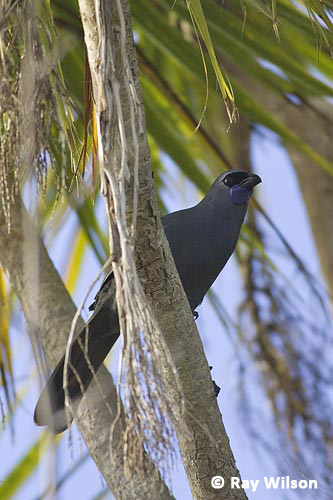
Kokako (Callaeas cinerea)
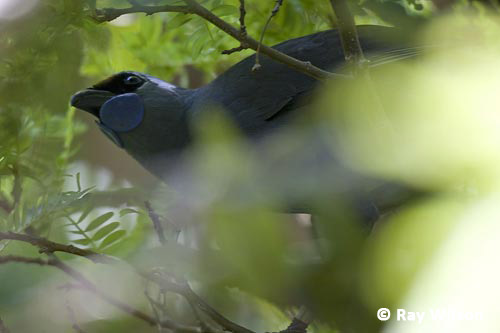
Kokako (Callaeas cinerea)
There are only about 15 Kokako on Tiritiri and they can be a bit inconspicuous at times. The Wharf Road and Wattle Valley Track seemed to be the most reliable places to see them when I was there.
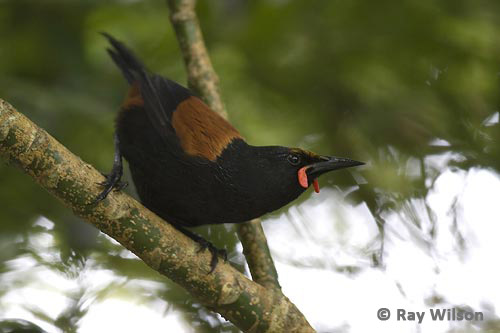
Saddleback (Philesturnus carunculatus)
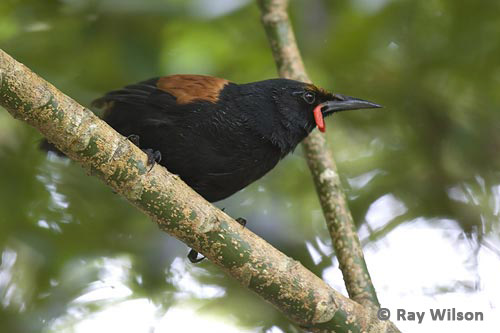
Saddleback (Philesturnus carunculatus)
Saddleback and Whiteheads are abundant throughout the island and their re-introduction has been so successful that it is difficult to remember that elsewhere in New Zealand these are rare birds.
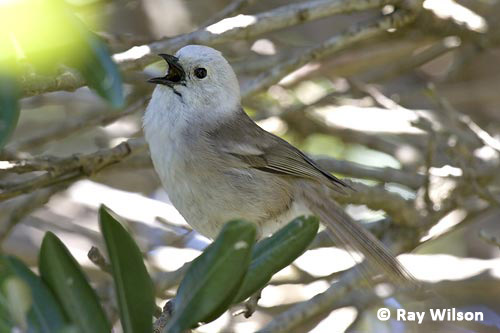
Whitehead (Mohoua albicilla) - more Whitehead photos
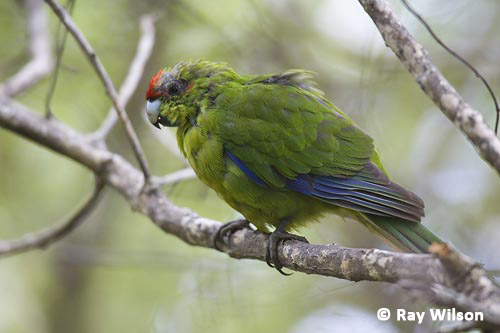
Red-crowned Parakeet (Cyanoramphus novaezelandiae)
The Red-crowned Parakeets kept to the dense cover most of the time and it was quite hard to get a reasonably clear shot of them. Typically, the most obliging individual (above) was also the scruffiest, and was missing a large patch feathers on its head.
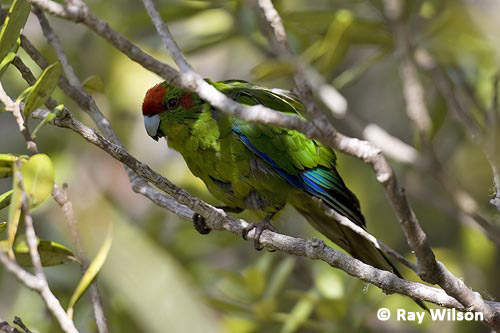
Red-crowned Parakeet (Cyanoramphus novaezelandiae)
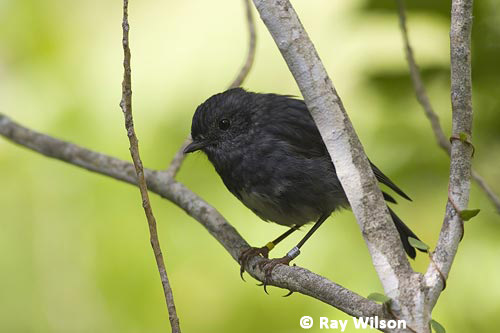
New Zealand Robin (Petroica australis)
The biggest problem I had photographing the Robins was getting far enough away from them to focus the camera! They would often come bouncing towards you or land in a branch close to your head, often only a few inches away. Initially, I thought this was because the researchers on the island fed them mealworms, but I encountered the same behaviour all over New Zealand so they were probably just exhibiting their natural curiosity.
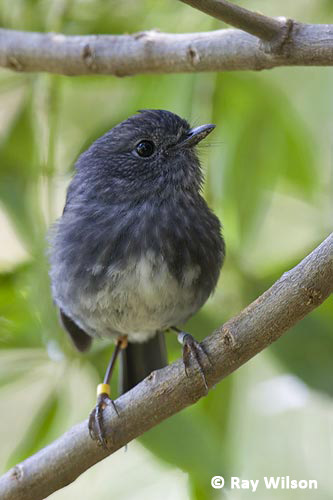
New Zealand Robin (Petroica australis)
The final two introduced endemics, Fernbird and Little Spotted Kiwi, are not so easy to see and I failed to get any photos of either of them.
Fernbirds can be seen in the area around the Brown Teal pool, but, as is typical for this species, they are very elusive and I only had brief flight views.
Finally, Little Spotted Kiwi can only be seen if you spend the night on the island. Space for visiting birders is limited in the bunkhouse (the only accommodation on the island), so if you want to see the kiwis it is essential to book well in advance. There are currently about 70 Kiwis on the island, but from what I've heard from other people who have stayed overnight, you are quite lucky if you get a glimpse of one. I count myself extremely fortunate to have seen one calmly walk out of the bush less than 30cm away, pause for a few seconds then walk across the path and into the undergrowth on the other side. Would have been better if I'd got a photo too, but that's just being greedy!
Kiwis are very sensitive to bright light, so flash photography is forbidden and all torches on the island must be covered with red cellophane. This, of course, makes it extremely difficult to focus the camera, and I gave up in favour of getting a decent view. Besides...I happened to have the 400mm lens on the camera at the time and a bird the size of a Little Spotted Kiwi would have to have been at least 10m away to be able to fit the whole bird in!
| Hauraki Gulf (pt.2) | New Zealand map | Tiritiri Matangi Island (pt.2) |
Ray Wilson owns the copyright of all images on this site.
They may not be used or copied in any form without prior written permission.
raywilsonphotography@googlemail.com